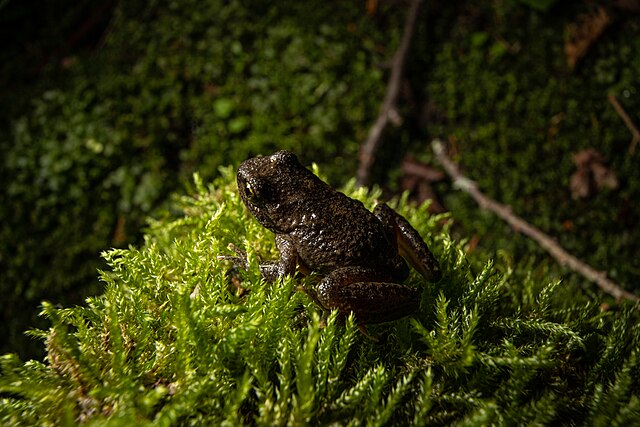Ascaphus montanus photo © GlacierNPS via Wikipedia Commons
De-tailed amphibians conceal a hiptail of unknown potential.
 Prof. Mumblebard claims: “Frogs are consistently tailless despite varying greatly in other respects and having diversified into some 50 families and five thousand species. The loss of the tail is so profound that it would be implausible for frogs to re-evolve a tail even if there were adaptive advantages in doing so. The two main orders of amphibians are thus aptly named from the ancient Greek word ‘ura’, meaning tail: Anura, the order of frogs, are tailless whereas Urodela, the order of salamanders, consistently possess a tail. Here we have one of the nicest phylogenetic splits among vertebrates, the anurans categorically lacking a tail and the salamanders categorically retaining the tail that is ancestral to all amphibians.”… See the hidden half of Prof. Mumblebard’s claim by subscribing here
Prof. Mumblebard claims: “Frogs are consistently tailless despite varying greatly in other respects and having diversified into some 50 families and five thousand species. The loss of the tail is so profound that it would be implausible for frogs to re-evolve a tail even if there were adaptive advantages in doing so. The two main orders of amphibians are thus aptly named from the ancient Greek word ‘ura’, meaning tail: Anura, the order of frogs, are tailless whereas Urodela, the order of salamanders, consistently possess a tail. Here we have one of the nicest phylogenetic splits among vertebrates, the anurans categorically lacking a tail and the salamanders categorically retaining the tail that is ancestral to all amphibians.”… See the hidden half of Prof. Mumblebard’s claim by subscribing here
 Robin and the Honey Badger respond: “The split between frogs and salamanders is not absolute and the apparent taillessness of frogs is misleading for two main reasons. Firstly, all larval frogs retain a tail – a structure familiar in the typical tadpole and one which remains long after the legs grow to a size typical of salamanders. This indicates that there could easily be natural selection for the retention of the caudal vertebrae in frogs, by similar means to the retention of gills in the axolotl and various other sexually mature salamanders. Furthermore, a hypothetical re-emergence of the ancestral tail in adult frogs is easy to envisage given that metamorphosis in amphibians – unlike that in butterflies – is gradual and flexible, allowing certain larval organs to persist to full maturity. And secondly, all adult frogs already retain a modified caudal skeleton, the disappearance of the tail during development being illusory. What appears to be consumption of the tail by the metamorphosing tadpole is really subsumption into the posterior part of the torso in the form of a hidden but substantial strut – formed of fused caudal vertebrae – called the urostyle. This results in the whole posterior slope of the convex back of the typical frog being reinforced by the modified caudal section of the vertebral column. No biologist doubts that this modification of the pelvic girdle includes a buried tail, yet the potential adaptive implications have been overlooked. Owing to the fact that tail bones are in fact retained in both larvae and adults of all amphibians, natural selection for an adult tail – similar to that consistently present in adult salamanders – remains possible in frogs. Indeed, evolution could reinstate the external tail far more easily in adult frogs than in other ‘tailless’ animals such as great apes because all that would be needed is a chronological shuffling of various organs along the metamorphic sequence, amounting to an indefinite delay in the process of subsumption of the tail. The real reason why no frog has converged with salamanders is that there is no ecological niche for salamanders in most of the habitats suitable for frogs.”
Robin and the Honey Badger respond: “The split between frogs and salamanders is not absolute and the apparent taillessness of frogs is misleading for two main reasons. Firstly, all larval frogs retain a tail – a structure familiar in the typical tadpole and one which remains long after the legs grow to a size typical of salamanders. This indicates that there could easily be natural selection for the retention of the caudal vertebrae in frogs, by similar means to the retention of gills in the axolotl and various other sexually mature salamanders. Furthermore, a hypothetical re-emergence of the ancestral tail in adult frogs is easy to envisage given that metamorphosis in amphibians – unlike that in butterflies – is gradual and flexible, allowing certain larval organs to persist to full maturity. And secondly, all adult frogs already retain a modified caudal skeleton, the disappearance of the tail during development being illusory. What appears to be consumption of the tail by the metamorphosing tadpole is really subsumption into the posterior part of the torso in the form of a hidden but substantial strut – formed of fused caudal vertebrae – called the urostyle. This results in the whole posterior slope of the convex back of the typical frog being reinforced by the modified caudal section of the vertebral column. No biologist doubts that this modification of the pelvic girdle includes a buried tail, yet the potential adaptive implications have been overlooked. Owing to the fact that tail bones are in fact retained in both larvae and adults of all amphibians, natural selection for an adult tail – similar to that consistently present in adult salamanders – remains possible in frogs. Indeed, evolution could reinstate the external tail far more easily in adult frogs than in other ‘tailless’ animals such as great apes because all that would be needed is a chronological shuffling of various organs along the metamorphic sequence, amounting to an indefinite delay in the process of subsumption of the tail. The real reason why no frog has converged with salamanders is that there is no ecological niche for salamanders in most of the habitats suitable for frogs.”
Please join us here at the Bio-edge with your own comments. In the discussion below we encourage links to any evidence supporting either Prof. Mumblebard or Robin and the Honey Badger. Illustrations are welcome but please cite all sources or we may be forced under copyright to delete your comment.
“The split between frogs and salamanders is not absolute and the apparent taillessness of frogs is misleading for two main reasons. Firstly, all larval frogs retain a tail – a structure familiar in the typical tadpole and one which remains long after the legs grow to a size typical of salamanders. This indicates that there could easily be natural selection for the retention of the caudal vertebrae in frogs, by similar means to the retention of gills[1] in the axolotl[2] and various other sexually mature salamanders. Furthermore, a hypothetical re-emergence of the ancestral tail in adult frogs is easy to envisage given that metamorphosis in amphibians – unlike that in butterflies – is gradual and flexible[3], allowing certain larval organs to persist to full maturity. And secondly, all adult frogs already retain a modified caudal skeleton, the disappearance of the tail during development being illusory. What appears to be consumption of the tail by the metamorphosing tadpole is really subsumption into the posterior part of the torso in the form of a hidden but substantial strut – formed of fused caudal vertebrae – called the urostyle[4]. This results in the whole posterior slope of the convex back of the typical frog being reinforced by the modified caudal section of the vertebral column. No biologist doubts that this modification of the pelvic girdle includes a buried tail, yet the potential adaptive implications[5] have been overlooked. Owing to the fact that tail bones are in fact retained in both larvae and adults of all amphibians, natural selection for an adult tail – similar to that consistently present in adult salamanders – remains possible in frogs. Indeed, evolution could reinstate the external tail far more easily in adult frogs than in other ‘tailless’ animals such as great apes because all that would be needed is a chronological shuffling of various organs along the metamorphic sequence, amounting to an indefinite delay in the process of subsumption of the tail. The real reason why no frog has converged with salamanders is that there is no ecological niche for salamanders in most of the habitats suitable for frogs[6].”
[1] Paedomorphosis involving the gills is known to occur in all ten families of Urodela.
[2] Amphibia: Urodela: Ambystomatidae: Ambystoma mexicanum
[3] This flexible system is called heterochrony.
[4] The urostyle, a skeletal rod formed from fused caudal vertebrae, is wholly internal, located completely in front of the cloaca within an abdomen of novel configuration. It serves as a spine for the elongated pelvic girdle typical of frogs. Whereas in most vertebrates the tail skeleton begins where the body ends, in adult frogs the cloaca has been shifted in a posterior direction with the lengthening of the ilia, thus enveloping the tail. Although the modified tail lies invisibly within the body, it remains – in all fully mature frogs – of comparable length with the head or thoracic spine. Although the urostyle is part of the morphological specialisation for hopping and leaping, many lineages of frogs have lost the typical mode of locomotion of frogs, instead crawling much as salamanders do.
[5] See bio-bullet x.
[6] See bio-bullet y.

